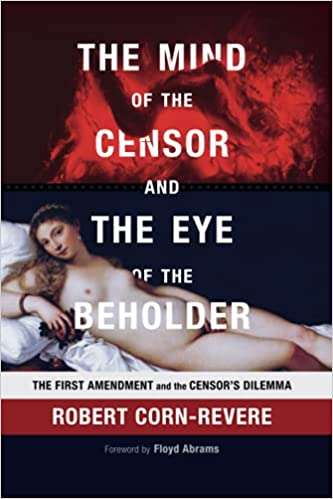The Volokh Conspiracy
Mostly law professors | Sometimes contrarian | Often libertarian | Always independent
The Return of Anthony Comstock, Part 2: The Comeback Trail
Things have turned around for Anthony Comstock of late. The old anti-smut crusader, who defined the role of the professional censor, and whose obsessions blotted out the law of free speech for more than 40 years beginning in the 1870s, was all but forgotten by the mid-twentieth century. Now, however, more than a century after his death, a bumper crop of books have appeared attesting to the old crusader's pivotal role in the history of freedom of speech and women's rights.
Amy Werbel's 2018 book Lust on Trial meticulously detailed Comstock's rise and fall, with a particular emphasis on art history, and concludes "the story of Comstock's efforts undeniably calls into question the efficacy of trying to control morality and sexuality by statute and prosecution." In fact, the magnitude of Comstock's influence may best be measured by the strength of the opposition he created.
By setting himself up as the Bond villain of censorship, he forced writers, artists, feminists, and free thinkers to devise better arguments supporting freedom of speech at a time before courts had caught on. Werbel observes that, ironically, "Comstock can be credited almost single-handedly with instigating the foundations of a First Amendment Bar."
Drawing on Werbel's work, novelist Annalee Newitz featured Comstock as the central antagonist in her 2019 book The Future of Another Timeline, about time-traveling feminists who do battle with "Comstockers"—as well as the old moralist himself—in 1893 (and various other times). Their quest is to prevent a Handmaid's Tale-type future from being engineered by travelers inspired by Comstock.
The historical research Newitz conducted for her book was repurposed for a September 2019 New York Times op-ed piece in which she dubbed Comstock "the original anti-feminist crusader." She warned "[h]is name may be forgotten, but the age of Comstockery is not over." Comstock's tactics—"a combination of media manipulation and ruthless legal strategies—are a precursor to those used by anti-feminists on social media and in Washington today."
Another Comstock biography, Amy Sohn's The Man Who Hated Women, dropped in mid-summer 2021, and it makes the case Comstock was "one of the most important men in the lives of nineteenth-century women" because of his crusades against contraceptives and abortion. Sohn details Comstock's crusades against "sex radicals"—those who openly advocated sexual liberation of women, access to contraceptives and abortion, and information about sexual health—and concludes the "sex radicals' legacy lies in their use of speech to fight the repression of speech."
Sohn expressly rejects "victim-oriented feminism," which she describes as "limited, inciting phobia and panic, turning sex into something that is only ugly, only dark, only violent." "Victim-oriented feminism," she writes, "robs women of their strength and robs the movement of the diversity that made way for the sex radicals." Her conception of free speech is as broad as Comstock's was narrow, and she observes that for the sex radicals, "[t]o oppose the Comstock laws was to oppose all restrictions on speech."
This was followed closely by Brett Gary's Dirty Works: Obscenity on Trial in America's First Sexual Revolution. The main focus of Gary's book is the pioneering work of ACLU attorney Morris Ernst and his free speech battles from the 1920s through the 1950s. However, in his opening chapter Gary makes clear those struggles were largely necessary to push back against the work of Comstock, whom he describes as "the most effective propagandist warning about the dangers of obscene materials," and "the nation's foremost censor and smut eradicator."
Ernst himself had a long and distinguished career that began after Comstock's death, but as Gary observes, "the key enemy was always Anthony Comstock, and the anti-intellectual, anti-modern, anti-sexual attitudes compressed into the label 'Comstockery.'" These retrograde attitudes had a "long life in the nation's laws, undergirding federal and state censorship policies and activities well into the 1950s and beyond." And Gary concludes that Comstock's influence has not vanished, and that "aspects of 'Comstockery's' patriarchal and restrictive impulses toward women remain powerful in the culture, especially in reproductive politics."
My own book, The Mind of the Censor and the Eye of the Beholder—The First Amendment and the Censor's Dilemma, is not a Comstock book per se, but devotes several chapters to Comstock's career and his role in defining what it means to be a morals crusader (or, as in current parlance, an "activist"). This occupation is not limited to either side of the political spectrum, and The Mind of the Censor describes how Comstock's methods continue to be used by advocates of all political persuasions against what they see as "speech crimes." By institutionalizing censorship as an entrepreneurial endeavor, Comstock set the tone and tactics of anti-speech activists to this day.
Half a century after Comstock's death, long after his name faded from the limelight, the editor of a re-issue of one of his books described Comstock as "the beau ideal of the American reformer" and "the spiritual father of today's youthful suburbanites who have undertaken to cleanse newsstands and drugstore magazine racks of 'objectionable' material." That observation from the 1960s is even more true in the context of some of today's battles over freedom of speech.
To be sure, none of these recent books paints Comstock in a sympathetic light. Indeed, none have a single good thing to say about him. But no matter; the renewed attention means Comstock is back in the game. More importantly, as these books make clear, Comstock largely defined the game.
[This post is based on the new book, The Mind of the Censor and the Eye of the Beholder: The First Amendment and the Censor's Dilemma.]

Show Comments (13)